The Alvin Ailey American Dance Theater performs at New York’s City Center.
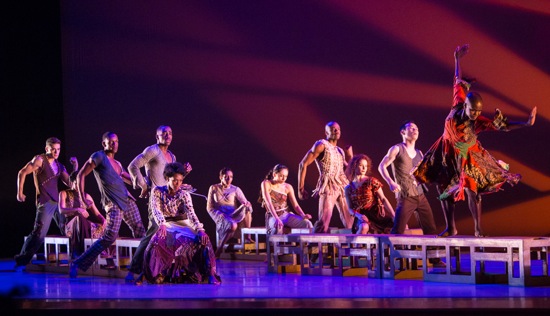
Alvin Ailey American Dance Theater in Matthew Rushing’s Odetta. (L to R): Michael Francis McBride, Belen Pereyra, Marcus Jarrell Willis, Renaldo Maurice, Rachael McLaren, Sarah Daley, Danica Paulos, Jermaine Terry, Megan Jakel, Kanji Segawa, and Hope Boykin. Photo: Yi-Chun Wu
The members of the Alvin Ailey American Dance Theater have always been able to do practically anything a choreographer might ask of them: thrust their legs astonishingly high, spin like tops, act sassy or sexy, and dance with an ardor that burns across the footlights. But it’s always exciting to see how they accommodate to the new challenges that being in a repertory company entails. And Robert Battle, who succeeded Judith Jamison as AAADT’s artistic director in 2011, has continue and expanded the tradition of giving them those challenges.
So, over two nights early in the company’s City Center season (through January 4), you could see them give their passionate all in Ailey’s iconic Revelations (1960) and Robert Moses’s The Pleasure of the Lesson (2014) with its semi-tribal atmosphere and dizzying lighting effects. But you could also see twenty of them dressed in black pants, white shirts, open black jackets, and black hats (the women have their hair slicked back or pinned up to minimize the gender gap). And in this dance, Ohad Naharin’s Minus 16 (acquired by AAADT in 2011), they may perform the same sequence many times, as crisply as soldiers, but also go out into the audience and prowl the aisles, each looking for a new partner to escort onto the stage, in order that the company members can dance for and with them. Samuel Lee Roberts begins the work, improvising alone with wonderful wit and crazed bursts of pleasure while the intermission that precedes Minus 16 is still winding down.
Naharin, the director of Israel’s Batsheva Dance Company, drew from five of his works to create Minus 16. Made in 1999, it celebrated his wife, the beautiful dancer Mari Kajiwara, who was to die of cancer in 2001. Perhaps not entirely coincidentally, two other works memorialized artists. Ailey choreographed his Memoria in 1979, the year choreographer Joyce Trisler— a former colleague of his in the Lester Horton Company, and a member of AAADT for a while during the 1960s—died unexpectedly. The title of Odetta, by Matthew Rushing (former company dancer, now a rehearsal director and guest artist) is self-explanatory; Rushing’s world premiere celebrates the many voices of this tremendous singer, song-writer, and political activist. Blues, folk, spirituals, jazz—she knew them all.
Given the date of Memoria’s premiere, Ailey must have created the piece while mourning Trisler, whom he loved, admired, and fought with. The dancers are clad in white and move to Keith Jarrett’s “Runes” and “Solara March”—music that blends treacle and transcendence. In the cast I saw, Linda Celeste Sims embodied Trisler, saluted and elevated by the others, but also performing as if on an emotional search of her own, sometimes she’s supported by two men who could represent Horton and Ailey. The beginning is a knockout, with men rushing in and out, bearing their partners high; the image is like spurting fountains. And Ailey was adept at creating telling and variegated patterns in space. Many of the steps are rooted in Horton class work or in Trisler’s own fine solo, Journey, although after a while, so many legs kicked high to the side so many times begin to look like a display of weaponry. It was a fine theatrical touch on Ailey’s part to weave lines of students from the Ailey School through the ensemble—first in white and then in rainbow colors.
I don’t know what Trisler would have made of this. A protégée of Doris Humphrey’s, a fascinating and unusual dancer, and a gifted choreographer, she was also tart and dry and witty (I danced in her company for a couple of years). For sure, she would have been happy that Ailey offered her this tribute.
Rushing’s homage to Odetta takes a different form, and her voice dominates the eponymous piece—essentially a suite of danced songs of all kinds, most of them recorded by Odetta, with Harry Belafonte joining her on “A Hole in the Bucket” and her “Freedom Trilogy” sung by Ysaye M. Barnwell, with Seth Farber on piano. The terrific Hope Boykin—wearing a swirling, mostly red dress by Dante Baylor that makes her look like a carnival on the move—functions as an embodiment of the great singer. Her movements assert power and hope, but she supports or consoles the others as well as mustering them. And Rushing has rendered those ten others as members of a community who watch and listen, as well as the individuals who dance the songs.
Projected images of Odetta appear; we hear her words, culled from speeches she made or interview questions she answered—speaking out for racial equality and against the war in Vietnam. One of the most creative aspects of Rushing’s work is George Travis’s set and the uses made of it. A number of long, slim, adroitly designed “benches” that appear to be made of blonde wood are carried about and rearranged by the dancers to fit the tone of the songs. (I enclose benches in quotes because they are also sometimes stood on end to suggest buildings or pushed together to become a single platform or set end-to-end in two lines to suggest railroad tracks.)
Rushing hasn’t been choreographing for very long (this is only his fourth work), and Odetta is definitely an impressive achievement. As you might expect, he occasionally uses steps that might have dropped in from other dances in the repertory, but more often he intuits what suits a particular song and makes the dancers’ bodies express that. So in “John Henry,” Renaldo Maurice seems really to be working himself to death with his big, flailing movements, and Kanji Segawa makes himself look small—huddled against adversity, and stumbling a little when Odetta sings “Sometimes I Feel Like a Motherless Child.” Megan Jakel whips herself into a frenzy of exaltation to “Glory, Glory,” and during “Cool Water,” Sarah Daley and Jermaine Terry cling together as if marooned and resisting being pulled apart by tides. Belen Pereyra takes the stage with fierce dignity during “Ox Driver Song.”
For the familiar, jokey, snake-eating-its-tale folk song, “There’s a Hole in the Bucket,” Rushing wisely decided to calm the stage down and illustrate the song with precise and very telling gestures. Odetta and Belafonte (who was in the audience the night Odetta premiered) let their voices start out relatively calmly and then become more exasperated (she) and more helplessly dopey (he). Rushing reflects the increasing tensions in their interchanges, and Rachel McLaren and Marcus Jarrell Willis perform wonderfully—she composed and tight-lipped, curt in her gestures, he loose and shrugging. They sit on two side by side on stools and, much of the time, look straight at the audience, a vaudeville duo making every gesture count.
Odetta sings Bob Dylan’s “Masters of War” to usher in “Glory, Glory” and the “Freedom Trilogy.” The fact that an American flag descends and hangs, half-hidden, behind the performers makes an obvious link between the war in Vietnam and today’s interventions in the Middle East. Michael Francis McBride and Danica Paulos are the lovers about to be separated by his military service. But what’s most moving is the way Rushing organizes the ensemble in this section. To “Masters of War,” the men march and march in repeated diagonal processions that progress in the same direction. Bit by bit, they change their appearance as they make their tight, thrusting, gestures and take their insistent rhythmic steps. They appear without their shirts, then acquire helmets, next time march with bandoliers strung across one shoulder. Between their appearances, the women rush onstage to interpolate their reactions. McBride gets his helmet, leaves his girl, and joins the marching line. Flashing lights and hurtling, thrashing bodies ensue. I didn’t expect to be so moved. By the music and how Rushing and the dancers allowed it to recruit them.
A few passages in Odetta are opaque. What, for instance, is the connection between Boykin and Jakel, who dance together like sisters or alter egos? Does it matter, in this case, that Jakel is white and Boyd black, signifying a hoped-for end to prejudice? Or. . . ?

Ulysses Dove’s Bad Blood (December 5th cast, L to R): Jacqueline Harris, Samantha Figgins, Jamar Roberts, Kirven Douthit-Boyd, Antonio Douthit-Boyd, Linda Celeste Sims, and Michael Francis McBride. Photo: Yi-Chun Wu
There’s nothing unclear visually about Ulysses Dove’s 1984 Bad Blood (a new production of a work acquired by AAADT in 1986). The subject is dance and relationships. Everything is pristine. And fierce. The seven dancers wear white practice clothes in varying designs (costumes by Carol Vollet Garner), and Beverly Emmons’s white lighting gives the stage the look of a cloudless day. A long bench at the back makes a variety of spatial designs possible (a powerful duet for Rachel McLaren and Yannick Lebrun happens mostly on and around the bench). Double or triple lengths of white rope form an X on the backcloth.
The music, however, is another matter. Not simple and clear at all. Two arresting works by Laurie Anderson and Peter Gabriel (“Excellent Birds” and “Gravity’s Rainbow”) and one by Anderson alone (“Walking and Falling”) surround the dance the way the noise of city streets—voices, traffic, sirens— surround a room in an apartment, or an intimate moment occurs amid a swarm of pedestrians. Anderson’s voice lives amid this, although City Center’s sound system ill serves her spoken scenario, which I know to be interesting. I catch only words and phrases now and then: “. . .falling and catching yourself from falling. . . ,” “. . .really think about ham and cheese sandwiches. . . ,” “. . .evil.”
The opening solo (marvelously performed by Antonio Douthit-Boyd the night I saw Bad Blood) introduces the style and motifs. He works his body—spinning across the space with angled arms raised, his hands curled into fists; dropping into a squat and shooting up onto taut, spread legs—and molds these and other vigorous moves into a vocabulary that repeats and is manipulated throughout the dance. He also stops and reclines, as if viewing the ghost of his own solo (although at that point, Anderson is singing “Looking out my window. . . .”).
The others explode onto the stage—sitting briefly on the bench, vaulting into jumps with their legs bundled under them, reiterating some of the soloist’s moves. There are four men in Bad Blood (I saw Douthit-Boyd, Lebrun, Collin Heyward, and Roberts), but only three women (Ghrai Devore, McLaren, and Pereyra). To make the inequality clear in a few seconds near the end, the men stand, each holding one arm out to the side; the women rush on, each to a partner; Douthit-Boyd remains, holding his arm out, waiting. Yet he walks offstage with McLaren at the end, leaving her erstwhile partner inert, draped backward over the bench.
Themes of attraction and rivalry power Bad Blood. Duets are its core, although Devore, Heyward, and Roberts mingle briefly in a trio, and there’s another ensemble section. Watching the dance, you gradually become aware of the rhythms and underlying images that Dove was working with. Many encounters between two people bring to mind the tension of a drawn bow and the swift release of its arrow—or a strong elastic band stretched to its maximum and allowed to snap. Two people pull away from the grasp of their hands; suddenly, the woman is in her partner’s arms or glued to his chest. Or a man and a woman separate and stand on opposite corners of the stage, eyeing each other; suddenly the woman takes off running toward the guy, and in seconds her arms and her legs are wrapped around him. Every embrace is a test, and the man not always the aggressor or the pillar of strength. Lebrun lies supine on the floor when McLaren stands above him, fists clenched.
Bad Blood (originally created for Les Ballets Jazz de Montréal in 1984 and premiering with the AAADT two years later) is a stunning work—clean and shining as a whistle, hinting at dark currents beneath. In it, Dove, who died shy of his 50th birthday, created an intriguing balance between minimalism and virtuosity. Members of this little group of people often enter the stage to dance and leave afterward, as if Bad Blood were presenting relationships between people in the form of rituals or contests. Elements in the spare movement vocabulary are recycled and rearranged and pushed onto unexpected adventures (that is, the dancing isn’t stuffed with steps with a new one every few seconds), and the Ailey dancers perform every one of those steps, not just with extreme clarity, but with intensity, strength, and passion.
As you would expect. And the company will be performing with that same fervor into 2015 —a true holiday gift.

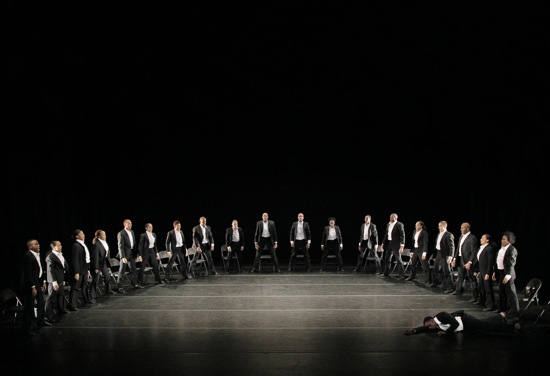
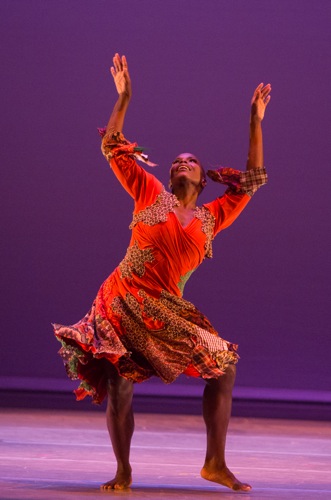
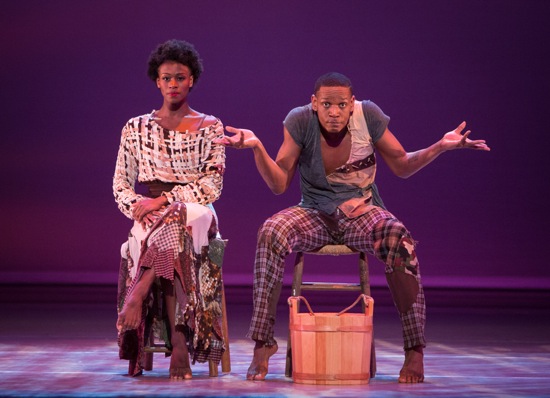
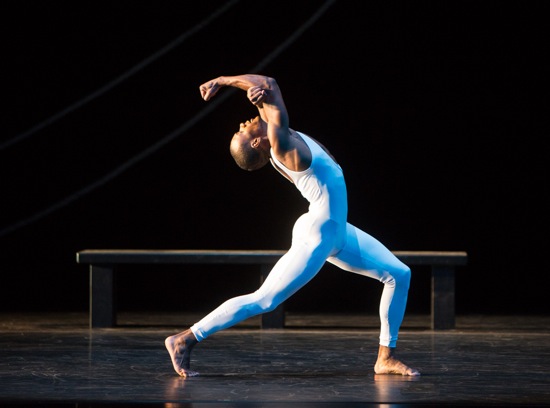
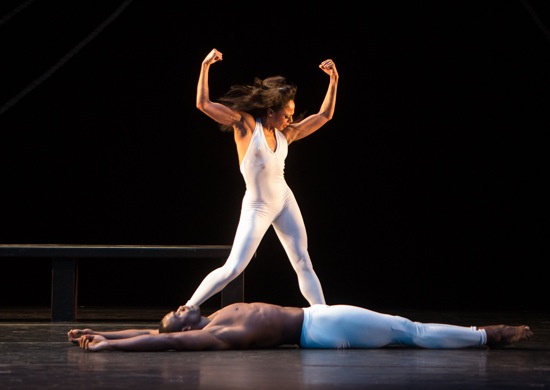
Many thanks for this thoughtful and right on review. After seeing Odetta and feeling it will work as a perfect replacement for dancers fatigued by repeating Revelations more often than they can stomach (not me as viewer – I could see it as many times as they could dance it). Alastair’s review in The Times made me wish, yet again, he’d just leave the modern dance reviews to others – period.
Thank you for describing the Ulysses Dove piece so clearly. I was stunned when I saw his work on Ailey a few years ago. What an amazing voice! I was riveted by how daring, direct, and, as you say, brilliantly minimal he was choreographically.
I’m sad to say I was a total newcomer to his work as he came before my time in NY and clearly we lost him too early. But the Ailey dancers did his work like magic. And now I’ll see any program with Dove on it any chance I get!